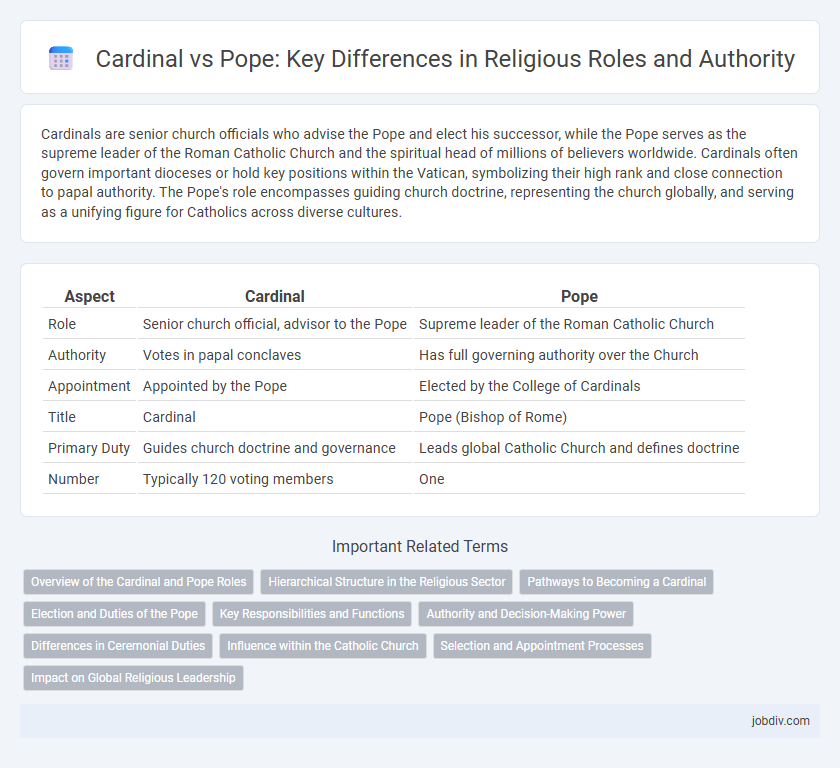Cardinals are senior church officials who advise the Pope and elect his successor, while the Pope serves as the supreme leader of the Roman Catholic Church and the spiritual head of millions of believers worldwide. Cardinals often govern important dioceses or hold key positions within the Vatican, symbolizing their high rank and close connection to papal authority. The Pope's role encompasses guiding church doctrine, representing the church globally, and serving as a unifying figure for Catholics across diverse cultures.
Table of Comparison
| Aspect | Cardinal | Pope |
|---|---|---|
| Role | Senior church official, advisor to the Pope | Supreme leader of the Roman Catholic Church |
| Authority | Votes in papal conclaves | Has full governing authority over the Church |
| Appointment | Appointed by the Pope | Elected by the College of Cardinals |
| Title | Cardinal | Pope (Bishop of Rome) |
| Primary Duty | Guides church doctrine and governance | Leads global Catholic Church and defines doctrine |
| Number | Typically 120 voting members | One |
Overview of the Cardinal and Pope Roles
Cardinals serve as senior church officials and advisors to the Pope, responsible for electing the new Pope during a conclave and overseeing various Vatican congregations. The Pope holds supreme spiritual authority over the Roman Catholic Church, guiding doctrine, liturgy, and global church governance. While cardinals manage administrative duties and regional church matters, the Pope functions as the ultimate religious leader and symbol of Catholic unity worldwide.
Hierarchical Structure in the Religious Sector
The hierarchical structure in the Catholic Church places the Pope as the supreme spiritual leader and head of the Vatican, holding ultimate authority over doctrine and governance. Cardinals rank directly below the Pope, serving as senior ecclesiastical leaders who advise him and are responsible for electing a new Pope during a conclave. This structured hierarchy ensures clear lines of authority and continuity within the religious governance of the Church.
Pathways to Becoming a Cardinal
Becoming a Cardinal involves a distinct pathway within the hierarchy of the Catholic Church, typically requiring prior ordination as a bishop and recognition for service or leadership. The Pope alone has the authority to appoint Cardinals, selecting individuals who often have significant experience in diocesan leadership, the Roman Curia, or diplomatic service. Cardinals serve as senior church officials and are responsible for electing a new Pope during a conclave, highlighting their pivotal role compared to the singular papal office.
Election and Duties of the Pope
The Pope is elected by the College of Cardinals through a conclave, where cardinals aged under 80 cast secret ballots until a candidate receives a two-thirds majority. Once elected, the Pope serves as the spiritual leader of the Roman Catholic Church, overseeing doctrine, liturgical practices, and global missionary activities. Cardinals, appointed by the Pope, primarily act as senior ecclesiastical leaders and advisors, while the Pope holds supreme authority in governance and represents the Church worldwide.
Key Responsibilities and Functions
Cardinals serve as senior church officials who advise the Pope, oversee important dioceses, and participate in the conclave to elect a new Pope. The Pope holds supreme authority as the spiritual leader of the Roman Catholic Church, defining church doctrine, guiding global Catholic policy, and representing the church worldwide. While cardinals support and influence key decisions, the Pope's primary functions include pastoral leadership, maintaining church unity, and exercising supreme legislative, executive, and judicial power within the church.
Authority and Decision-Making Power
The Pope holds supreme authority in the Roman Catholic Church, possessing ultimate decision-making power over doctrinal, liturgical, and administrative matters. Cardinals serve as chief advisors and electors of the Pope but do not wield the same level of autonomous authority. While cardinals influence church governance and policy, the Pope's decisions are final and binding across the global Catholic community.
Differences in Ceremonial Duties
Cardinals primarily participate in consistory meetings, advising the Pope and electing his successor during a conclave, while the Pope presides over major religious ceremonies such as Easter Mass and canonizations. Cardinals often serve as papal legates, representing the Pope at important events, whereas the Pope conducts liturgical functions as the supreme pontiff of the Catholic Church. The ceremonial duties of the Pope encompass universal church leadership and doctrinal formalization, contrasting with the more localized or advisory roles of cardinals.
Influence within the Catholic Church
Cardinals hold significant influence within the Catholic Church by serving as principal advisors to the Pope and participating in the conclave to elect a new pontiff. The Pope, as the supreme leader, wields ultimate authority over doctrinal decisions, global Church governance, and the appointment of bishops worldwide. While Cardinals impact Church policy and leadership selection, the Pope's influence shapes the Church's universal direction and spiritual guidance.
Selection and Appointment Processes
Cardinals are appointed by the Pope, selected from among bishops and distinguished clergy, often based on their experience and service within the Church. The Pope, as the supreme pontiff, is elected during a conclave by the College of Cardinals, who gather in the Sistine Chapel to vote in strict secrecy. The selection of a Pope requires a two-thirds majority, emphasizing the importance of consensus among the highest-ranking Church officials.
Impact on Global Religious Leadership
Cardinals serve as principal advisors to the Pope and play a critical role in electing a new Pontiff, thereby shaping the future direction of the Catholic Church. The Pope, as the supreme spiritual leader, holds ultimate authority over global religious doctrine, governance, and interfaith outreach, influencing millions of adherents worldwide. The dynamic between Cardinals and the Pope ensures a balance of advisory input and centralized leadership critical to sustaining the Church's global presence and impact.
Cardinal vs Pope Infographic

 jobdiv.com
jobdiv.com